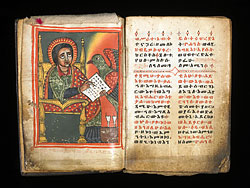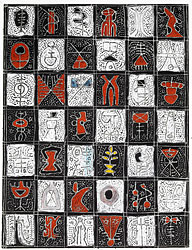 |
|
Writing systems have flourished in Africa for thousands of years and have contributed significantly to the global history of writing. In Inscribing Meaning, artworks from a range of periods, regions and media testify to the rich diversity of scripts and forms of graphic communication. They challenge conventional understandings of the written word as something static applied only to paper, and they demonstrate the dynamic ways that artists from many African cultures have creatively used script, or the idea of script, in their works of art.
Scripts are systems of interrelated symbols used to encode and transmit meaning. In Africa, these scripts take a variety of forms. Some are phonetic alphabets, in which letters or characters represent the sounds of a language, while others are ideographic, comprised of abstract symbols that convey concepts, ideas or things. All of these scripts possess a dramatic, visual power that has inspired artists to deploy them in myriad ways and contexts. Whether inscribed on ritual or everyday objects, textiles, the human body or in books, these African scripts are more than technologies of communication. They constitute versatile, aesthetically potent ways of knowing and affecting the world.
The mix of traditional and contemporary works of art featured in this exhibition underscores the versatility of script and its great potential as a social, political, religious and popular art form both in Africa and its diaspora. Indeed, many artists have used script to explore intersections of art and society with intriguing results.
|

Asafo company flag
Artist: Kobina Badowa
Fante peoples
Ghana
ca. 1970
H x L: 180 x 113 cm [74 x 44.4 in]
Cotton fabric
Fowler Museum at UCLA
x86.1970
"All our enemies are vultures." This provocative inscription is written in Roman letters in Twi, one of Ghana's major languages. It proclaims the superiority of the asafo company, which owned this flag, over its rivals, who are compared to unpleasant, offensive carrion-eating birds.
Asafo companies serve political, religious and civic functions. These centuries-old traditional military institutions are particularly strong among the Fante, an Akan group of south-central Ghana. Flags and banners are typically emblazoned with words and images linked to proverbs and to specific events in a company's history. Understanding such messages conveyed in asafo regalia requires specialized knowledge and literacy, abilities linked to power and authority.
The use of Roman script reflects Africa's centuries of interaction with the West. During the colonial period (late 19th century to circa 1960), Western authorities imposed European languages and literacy in matters of government, religion and the economy to foster their ideas and legitimize their domination. This flag demonstrates how Twi-speaking peoples employed Roman script for their own purposes, namely, to display the authority connected with a mastery of multiple languages and scripts.
|

Stela of the Overseer of the Treasurers of Isi
Egyptian
1783-1640BCE, Middle Kingdom, Dynasty 13
Limestone
H x W x D: 39.6 x 25 x 6.5 cm.
Metropolitan Museum of Art
68.14
Isi, the Overseer of the Treasurers, and members of his family are identified in hieroglyphic texts. Careful study of the vertical registers and the orientation of the animals and human hieroglyphs suggest which ones belong to each figure on this stela, a stone tablet inscribed with relief designs or texts commemorating an event.
|

Bi-Folio from the Qur'an
Egypt
Late 14th century
Ink, pigment, and gold on paper
H x W: 37.8 x 53.2 cm. (14 7/8 x 20 15/16 in.]
Sackler Gallery, S1995.115a-d
This folio is written in muhaqqaq, a cursive style of Arabic favored in the 14th and 15th centuries for large versions of the Qur'an, Islam's sacred book. It carries the last verse of sura (chapter) 28 and the illuminated heading to chapter 29. It is from a section of a 32-volume Qur'an that was given to a religious school in Tripoli built and endowed by Amir Aytamish, a Mamluk high commander.
Reading from right to left, sura 28, verse 88, states: "You shall not worship beside God any other god. There is no other god beside Him. Everything perishes except His presence. To Him belongs all sovereignty, and to Him you will be returned." Sura 29 begins: "In the name of God, Most Gracious, Most Merciful."
|

Mask
Igbo peoples
Nigeria
Wood, textile, plant fiber, glass beads, metal, buttons, kaolin, encrustation
H x W x D: 47 x 30 x 23 cm (18 1/2 x 11 13/16 x 9 1/16 in.)
Gift of Geraldine Dimondstein and museum purchase
2004-11-2
The face of this superbly rendered maiden mask is ornamented with uli, a graphic system referring to natural phenomena and human-made things that express ideas central to the Igbo worldview. Although men's bodies can be decorated with uli, it is traditionally an art form used by women to beautify their bodies as well as their homes and shrines.
This mask, worn with a colorful appliquéd costume, represents a young maiden whose ideal beauty is reflected in the mask's elegant features, facial markings set against a whitened surface, an elaborate coiffure and beaded ornamentation. The circular design on the cheek, reminiscent of the nsibidi sign meaning words, voice or meeting, suggests the influence of nsibidi in Igbo areas.

|

Book with illustration of scribe
[manuscript, probably a Book of Prayers to the Virgin Mary with Illustrations]
Ethiopia
Date: 18th century, Second Gondar Style
Paper, pigment
H x W x D: 11.4 x 17.7 x 4.5 cm. (4 31/64 x 6 31/32 x 1 49/64 in.)
Private Collection [Robert and Nancy Nooter]
In Ethiopia, priests and monks who served as scribes wrote and illustrated illuminated books. All manuscripts were painstakingly created by hand from parchment cut to size. Images painted in Gospel books focus on scenes of Christ's life, in particular the Crucifixion, the Entombment and the Ascension. Illuminated manuscripts may include canon tables, conceived in the 4th century A.D., that link Gospel narratives with the Four Evangelists-Matthew, Mark, Luke and John. The earliest books tend to restrict imagery to frontispieces, but regional variations often insert pictures within the body of texts. Here, a scribe or an apostle is shown in the act of writing; the text appears on the opposite page.
|

Ibiebe ABC III
Bruce Onobrakpeya born 1932, Nigeria
2000
Additive Plastograph print and ink on paper
H x W: 106.7 x 79.2 cm (42 x 31 3/16 in.)
H x W: 89.6 x 68.8 cm (35 1/4 x 27 1/16 in.) (image size)
Museum purchase
The Ibiebe series by Bruce Onobrakpeya features his invented script of ideographic geometric and curvilinear glyphs. The designs reflect the artist's knowledge of his Urhobo heritage, rich in symbols and the proverbs they elicit, as well as his appreciation of Chinese and Japanese calligraphy. Onobrakpeya invented and refined this script from 1978 to 1986, when he revisited in his art ideas linked with traditional religion, customs and history. The artist clearly delights in the script's forms and visual qualities as well as its power to communicate.
|
|

|










